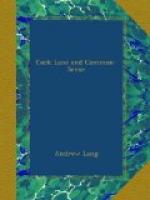There are others, however, who are no more hypnotised by crystal-gazing than tea-drinking, or gardening, or reading a book, and who can still enjoy visions as beautiful as those of the opium eater, without any of the reaction. Their condition remains perfectly normal, that is, they are wide awake to all that is going on. In some way their fancy is enlivened, and they can behold, in the glass, just such vivid pictures as many persons habitually see between sleeping and waking, illusions hypnagogiques. These ‘hypnagogic illusions’ Pontus de Tyard described in a pretty sonnet, more than three hundred years ago. Maury, in his book on dreams has recorded, and analysed them. They represent faces, places, a page of print, a flame of fire, and so forth, and it is one of their peculiarities that the faces rapidly shift and alter, generally from beautiful to ugly. A crystal-seer seems to be a person who can see, in a glass, while awake and with open eyes, visions akin to those which perhaps the majority of people see with shut eyes, between sleeping and waking. {214} It seems probable that people who, when they think, see a mental picture of the subject of their thoughts, people who are good ‘visualisers,’ are likely to succeed best with the crystal, some of them can ‘visualise’ purposely, in the crystal, while others cannot. Many who are very bad ‘visualisers,’ like the writer, who think in words, not in pictures, see bright and distinct hypnagogic illusions, yet see nothing in the crystal, however long they stare at it. And there are crystal-seers who are not subject to hypnagogic illusions. These facts, like the analogous facts of the visualisation of arithmetical figures, analysed by Mr. Galton, show interesting varieties in the conduct of mental operations. Thus we speak of ‘vision’ in a poet, or novelist, and it seems likely that men of genius ‘see’ their fictitious characters and landscapes, while people of critical temperament, if they attempt creative work, are conscious that they do not create, but construct. On the other hand many incompetent novelists are convinced that they have ‘vision,’ that they see and hear their characters, but they do not, as genius does, transfer the ‘vision’ to their readers.
This is a digression from the topic of hallucinations caused by gazing into a clear depth. Forms of crystal-gazing, it is well known, are found among savages. The New Zealanders, according to Taylor, gaze in a drop of blood, as the Egyptians do in a drop of ink. In North America, the Pere le Jeune found that a kind of thought reading was practised thus: it was believed that a sick person had certain desires, if these could be gratified, he would recover. The sorcerers, therefore, gazed into water in a bowl expecting to see there visions of the desired objects. The Egyptian process with the boy and the ink, is too familiar to need description. In Scott’s Journal (ii. 419) we read of the excitement which the reports of Lord Prudhoe {215}




